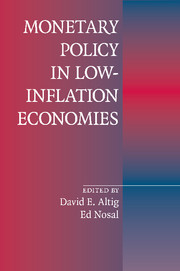Book contents
- Frontmatter
- Contents
- Contributors
- Acknowledgments
- Introduction
- 1 The Welfare Cost of Inflation in the Presence of Inside Money
- Commentary
- 2 An Open-Economy Model of Endogenous Price Flexibility
- Commentary
- 3 Efficient Inflation Targets for Distorted Dynamic Economies
- Commentary
- 4 Inflation and Welfare in Models with Trading Frictions
- Commentary
- 5 Good versus Bad Deflation: Lessons from the Gold Standard Era
- Commentary
- 6 Monetary Policy Orientation in Times of Low Inflation
- Commentary
- 7 Observations on Disinflation in Transition Economies
- Commentary
- 8 Inflation and Financial Market Performance: What Have We Learned in the Last Ten Years?
- Commentary
- Index
3 - Efficient Inflation Targets for Distorted Dynamic Economies
Published online by Cambridge University Press: 26 January 2010
- Frontmatter
- Contents
- Contributors
- Acknowledgments
- Introduction
- 1 The Welfare Cost of Inflation in the Presence of Inside Money
- Commentary
- 2 An Open-Economy Model of Endogenous Price Flexibility
- Commentary
- 3 Efficient Inflation Targets for Distorted Dynamic Economies
- Commentary
- 4 Inflation and Welfare in Models with Trading Frictions
- Commentary
- 5 Good versus Bad Deflation: Lessons from the Gold Standard Era
- Commentary
- 6 Monetary Policy Orientation in Times of Low Inflation
- Commentary
- 7 Observations on Disinflation in Transition Economies
- Commentary
- 8 Inflation and Financial Market Performance: What Have We Learned in the Last Ten Years?
- Commentary
- Index
Summary
THE TASKS OF MONETARY POLICY
Most central banks in OECD countries intervene in credit markets to achieve a target level of the short-term nominal interest rate and the long-term inflation rate (Bernanke and Mishkin 1992). The influential paper by Taylor (1993) suggests that Federal Reserve policy is well characterized by a simple rule in which the central bank sets the short-term nominal interest rate as a linear function of the lagged inflation rate and of lagged output deviations from their target values. Taylor argues that an active policy rule, with the coefficient on inflation greater than one, ensures macroeconomic stability. If the nominal interest rate has a more than one-for-one response to any change in inflation, then the central bank is able to influence the real interest rate and deter inflationary pressures.
Benhabib, Schmitt-Grohe, and Uribe (2001a), on the other hand, observe that active policy rules may have unintended consequences if one considers the zero bound on the nominal interest rate. The steady-state equilibrium for an active policy rule may be locally unique, but at the same time, multiple trajectories may exist around the steady state that eventually converge to a deflationary liquidity trap with a zero nominal interest rate. This global indeterminacy is robust to wide variations of parametric values (e.g., slope of Taylor rule, the long-run inflation target, consumption velocity of money, etc.) and holds for a fairly general class of monetary models with both flexible and sticky prices.
- Type
- Chapter
- Information
- Monetary Policy in Low-Inflation Economies , pp. 61 - 80Publisher: Cambridge University PressPrint publication year: 2009
- 1
- Cited by



